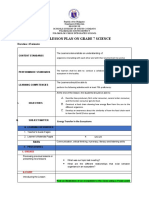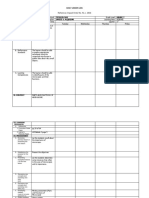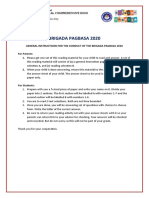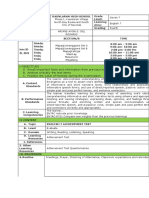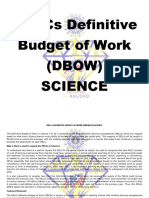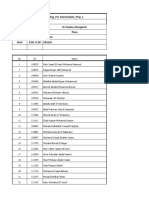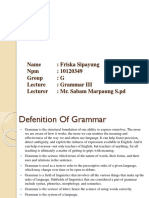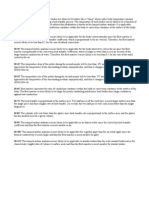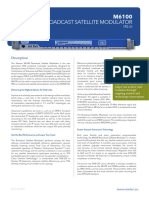Lesson Plan With Gad Integration 2
Lesson Plan With Gad Integration 2
Uploaded by
Jesusa Gregory HabigCopyright:
Available Formats
Lesson Plan With Gad Integration 2
Lesson Plan With Gad Integration 2
Uploaded by
Jesusa Gregory HabigOriginal Description:
Copyright
Available Formats
Share this document
Did you find this document useful?
Is this content inappropriate?
Copyright:
Available Formats
Lesson Plan With Gad Integration 2
Lesson Plan With Gad Integration 2
Uploaded by
Jesusa Gregory HabigCopyright:
Available Formats
LESSON PLAN WITH GAD INTEGRATION 2
OBJECTIVES
A. Content Standards The learners demonstrate an understanding of the properties of solutions.
B. Performance The learners shall be able to: 1. prepare solutions of different concentrations
Standards using locally available materials.
C. Learning Competencies/ The learners should be able to identify the factors that affects solubility.
Objectives
CONTENT Factors Affecting Solubility
LEARNING Science 7 Learner’s Material Pages 8-10
RESOURCES www.sciencegeek.net/Chemistry/Powerpoint2/SolutionProperties.ppsx
PROCEDURES
A. Reviewing previous Ask the following:
lesson or presenting the What is a solution? What are the components of a solution? What makes the
new lesson. solution homogeneous? How solutions are formed?
B. Establishing a purpose Brainstorming: Which has more fish – a pond with cold water or a pond with
for the lesson/motivation. warm water? Why?
C. Presenting Describe how they prepare their milks, coffee or juice at home. Ask their
examples/instances of the observations on the instances where those solutions are being dissolved fast
new lesson or slow.
D. Discussing new Discuss the factors that affects solubility.
concepts and practicing Solubility is the maximum concentration of a solute that can dissolve in a
new skills #1 solvent at a given temperature. At the maximum concentration of solute, the
solution is said to be saturated. The units of solubility are often provided in
mol/L or g/L.
Factors that affect solubility include: concentration of solute, temperature,
pressure (for gas) and polarity of solute and solvent.
E. Discussing new Discuss some ways to increase dissolution.
concepts and practicing Dissolving rate of a substance refers to the rate at which the substance (solute)
new skills #2 dissolves in another substance (solvent). To speed up the dissolving process,
you can do the following things: stirring, heating the mixture and grind the
solute.
F. Developing mastery Present diagrams on the effect of temperature, pressure and surface area on
(Leads to Formative the solubility of solute.
Assessment 3)
G. Finding practical Imagine humans as gas molecules of a solute and the whole big world as the
applications of concepts container of the solution. How would they react when pressured, heated and if
and skills in daily living. they are small or big particles in a solution? How males and females react as
molecules in a solution to make this world homogeneous or equal?
H. Making generalizations Make a summary on the factors affecting solubility.
and abstractions about
the lesson
I. Evaluating learning True or False (5 items)
J. Additional activities for None
application or remediation
REMARKS
REFLECTION
A. No. of learners who
earned 80% in the
evaluation.
B. No. of learners who
require additional
activities for remediation
who scored below 80%
C. Did the remedial None. All students passed the quiz.
lesson work? No. of
learners who have caught
up with the lesson.
D. No. of learners who None
continue to require
remediation
E. Which of my teaching Diagrammatic Approach highly tests the students’ analyzing skill by looking at
strategies worked well? diagrams and explaining it.
Why did these work?
F. What difficulties did I None
encounter which my
principal or supervisor can
help me solve?
G. What innovation or None
localized materials did I
use/discover which I wish
to share with other
teachers?
Prepared by: Checked by: Noted:
You might also like
- Lab Grown Diamond at SuratDocument17 pagesLab Grown Diamond at SuratSanjay Thakkar100% (1)
- SCIENCE 7 Lesson ExemplarDocument1 pageSCIENCE 7 Lesson ExemplarCarzi Canete50% (2)
- Science: Modified Strategic Intervention MaterialDocument14 pagesScience: Modified Strategic Intervention MaterialGalang Alpha100% (2)
- DLL Science Grade 8 Week 1Document3 pagesDLL Science Grade 8 Week 1AbramBarangan78% (18)
- Cot DLP Science 7Document24 pagesCot DLP Science 7Freshnida Insong100% (3)
- DLLDocument5 pagesDLLPhoebe Sudweste QuitanegNo ratings yet
- Daily Lesson Plan On Grade 7 Science: Duration: 45 MinutesDocument4 pagesDaily Lesson Plan On Grade 7 Science: Duration: 45 MinutesRobert Kier Tanquerido TomaroNo ratings yet
- B. Learner's Material pp.1-4: II. Ways of Acquiring Knowledge and Solving ProblemsDocument2 pagesB. Learner's Material pp.1-4: II. Ways of Acquiring Knowledge and Solving ProblemsLeizylAlcantaraNo ratings yet
- List of Least Learned Competencies With Interventions ConductedDocument2 pagesList of Least Learned Competencies With Interventions ConductedGerry Chel-Nunez Awa-Laurente Aga100% (1)
- Sym Fiddle125 Service ManualDocument182 pagesSym Fiddle125 Service Manualdanielaat100% (1)
- EH-EM Service Instructions Coin-Logi-Intelli Control 344739, 11-6Document46 pagesEH-EM Service Instructions Coin-Logi-Intelli Control 344739, 11-6Hugo RoMo67% (3)
- Konica Minolta Regius Model 110 Spare PartsDocument64 pagesKonica Minolta Regius Model 110 Spare PartsValentin100% (1)
- DLL Hots DemoDocument4 pagesDLL Hots DemoCatherine Gutierez-De GulaNo ratings yet
- 3rd-7e's - LOCATING PLACESDocument3 pages3rd-7e's - LOCATING PLACESRod ReyesNo ratings yet
- Appearance of Heterogeneous MixtureDocument5 pagesAppearance of Heterogeneous MixtureSharmaine Ramirez100% (2)
- NLC TemplateDocument3 pagesNLC TemplateRex YuzonNo ratings yet
- NRP 2Document6 pagesNRP 2Rhea Bercasio-Garcia100% (2)
- DLL Science 7 - Matter 1Document3 pagesDLL Science 7 - Matter 1Rea Audencial Quezada100% (1)
- JHS DemoDocument4 pagesJHS DemoGenie Soriano100% (1)
- DAILY LESSON LOG in Grade 7 Science - Week 2Document3 pagesDAILY LESSON LOG in Grade 7 Science - Week 2janice alquizar100% (1)
- 2q Science 9 Module 1 Rbi Script FinalDocument9 pages2q Science 9 Module 1 Rbi Script FinalDdj Soinluv100% (2)
- Learning Competency Directory in Science 7 First Quarter: Region III Guzmanville, Sto. Cristo, City of San Jose Del MonteDocument5 pagesLearning Competency Directory in Science 7 First Quarter: Region III Guzmanville, Sto. Cristo, City of San Jose Del MonteBerith Grace Magcalas-Gallardo100% (1)
- Sample DLL Catch Up FridayDocument11 pagesSample DLL Catch Up Fridayalice mapanaoNo ratings yet
- Science 7-Q1-Week3Document4 pagesScience 7-Q1-Week3rugie madronesNo ratings yet
- Science 7 Lesson Exemplar Biological Organization Q2Document16 pagesScience 7 Lesson Exemplar Biological Organization Q2Marian Anion-GauranoNo ratings yet
- DLL 7Document40 pagesDLL 7Caren Deadio AliligayNo ratings yet
- Detailed Lesson PlanDocument8 pagesDetailed Lesson PlanGlen Millar100% (1)
- Criteria Sci DokuDocument2 pagesCriteria Sci DokuBrianna Dela TorreNo ratings yet
- Science Grade 7 Test BankDocument3 pagesScience Grade 7 Test BankAlisha EnguanchoNo ratings yet
- Daily Lesson Log: 4. Describe Ways of Using Earth'S Resources Sustainably S7Es-Ivc-4Document2 pagesDaily Lesson Log: 4. Describe Ways of Using Earth'S Resources Sustainably S7Es-Ivc-4Pocholo GarciaNo ratings yet
- DLP in Demo Chem 1Document4 pagesDLP in Demo Chem 1Jeffrey YumangNo ratings yet
- RPMS SY 2021-2022: Teacher Reflection Form (TRF)Document8 pagesRPMS SY 2021-2022: Teacher Reflection Form (TRF)Giel RyzenNo ratings yet
- SCIENCE 7 DLP For Class Observation (3rd Quarter)Document2 pagesSCIENCE 7 DLP For Class Observation (3rd Quarter)Malixi Integrated School (CARAGA - Surigao del Sur)100% (1)
- IWAR April 2024 FaundoDocument3 pagesIWAR April 2024 FaundoMarlene L. FaundoNo ratings yet
- S4 - SD With Notes - HOTS in Practice (Science)Document39 pagesS4 - SD With Notes - HOTS in Practice (Science)cybejeza07No ratings yet
- DLL-G7 First Quarter Lesson 3Document3 pagesDLL-G7 First Quarter Lesson 3Kathryna Valencia Rosita100% (1)
- SD - Science 7 - Session 7BDocument74 pagesSD - Science 7 - Session 7BMacver Santos San AgustinNo ratings yet
- Strategic Intervention Materials in Teaching MotionDocument31 pagesStrategic Intervention Materials in Teaching MotionLea Magpantay-bascoNo ratings yet
- Lesson ExemplarDocument3 pagesLesson ExemplarMark Hernand Galapate0% (1)
- NLC Lesson PPT TemplateDocument4 pagesNLC Lesson PPT Templatepablo atacadorNo ratings yet
- 7es DLL TemplateDocument2 pages7es DLL TemplateSherCabs100% (1)
- TRF 9 10Document9 pagesTRF 9 10Arthur LegaspinaNo ratings yet
- 7e's LP 1stDocument4 pages7e's LP 1stCarmina Duldulao100% (1)
- Sample IG (Lesson Plan) For Sy 2015-2016Document5 pagesSample IG (Lesson Plan) For Sy 2015-2016Daniel Vicencio78% (9)
- Narrative Report PRIMALS PLUSDocument3 pagesNarrative Report PRIMALS PLUSDHEMIE PIODONo ratings yet
- Action Plan On The Implementation of The Project Tim (Teachers' Innovative Materials) in EnscimaDocument2 pagesAction Plan On The Implementation of The Project Tim (Teachers' Innovative Materials) in EnscimaQUEENLY NAQUINESNo ratings yet
- Reading Selection in ScienceDocument4 pagesReading Selection in ScienceBenes Salamanca BolascoNo ratings yet
- Grade 8 Activity Sheet Week 3 ScienceDocument3 pagesGrade 8 Activity Sheet Week 3 ScienceIvy Montecalvo100% (1)
- DLP Achievement TestDocument3 pagesDLP Achievement Testariane galenoNo ratings yet
- A Lesson Plan in Grade 8 - Science I. Session ObjectivesDocument2 pagesA Lesson Plan in Grade 8 - Science I. Session ObjectivesGlenn Stephen MahinayNo ratings yet
- Russell - LAC REFLECTION JOURNALDocument4 pagesRussell - LAC REFLECTION JOURNALAngelo Soriano100% (1)
- DLL IN Science 7 WEEK 3Document8 pagesDLL IN Science 7 WEEK 34K's Graphics100% (1)
- Curriculum Guide: Instructional PlanningDocument6 pagesCurriculum Guide: Instructional PlanningJohn Perseus LeeNo ratings yet
- Science: Quarter 3: Week 6 Learning Activity SheetsDocument8 pagesScience: Quarter 3: Week 6 Learning Activity SheetsFrances Datuin100% (1)
- Separation Techniques LPDocument2 pagesSeparation Techniques LPPeejay Canuto100% (1)
- Daily Lesson Log in Science 9Document5 pagesDaily Lesson Log in Science 9Nenita EscondeNo ratings yet
- DLL Science 8-4thQ-1.1Document2 pagesDLL Science 8-4thQ-1.1anon_298904132100% (1)
- Unpacked CompetenciesDocument13 pagesUnpacked CompetenciesJunalyn Tadle - ZaragosaNo ratings yet
- Science 7 Sample DLLDocument4 pagesScience 7 Sample DLLE-Joi del MundoNo ratings yet
- Annotation Kra 4 Objective 16Document2 pagesAnnotation Kra 4 Objective 16anngiley bangaNo ratings yet
- Lesson Exemplar Science Melc 3Document6 pagesLesson Exemplar Science Melc 3Mark Gil Jalbuena AltezaNo ratings yet
- Activity Sheet W AnswersDocument2 pagesActivity Sheet W AnswersKaren Fisalbon Napalla0% (1)
- Science DBOWDocument86 pagesScience DBOWLUCYNIL OBERESNo ratings yet
- Lesson Plan SAMPLEDocument4 pagesLesson Plan SAMPLECelina Dela CruzNo ratings yet
- Research Lesson PlanDocument4 pagesResearch Lesson PlanJesusa Gregory HabigNo ratings yet
- SIM - VariablesDocument21 pagesSIM - VariablesJesusa Gregory HabigNo ratings yet
- Science DLPDocument2 pagesScience DLPJesusa Gregory HabigNo ratings yet
- Youth For Environment in Schools Organization (Yes-O) Action Plan Junior High School School Year 2018 - 2019Document6 pagesYouth For Environment in Schools Organization (Yes-O) Action Plan Junior High School School Year 2018 - 2019Jesusa Gregory Habig100% (1)
- 1 Introduction To Moral TheologyDocument25 pages1 Introduction To Moral TheologyBea Dacillo Bautista100% (2)
- 2ND Quarter Exam Science 8Document3 pages2ND Quarter Exam Science 8Reyna Myra Estrada100% (2)
- Nclex New Lastest New LastDocument266 pagesNclex New Lastest New LastNadim Khalid0% (2)
- Einstein's Attitude Towards Experiments - Testing Relativity Theory 1907-1927 (Klaus Hentschel)Document32 pagesEinstein's Attitude Towards Experiments - Testing Relativity Theory 1907-1927 (Klaus Hentschel)evan6402No ratings yet
- Linear Momentum: L.O. Define MomentumDocument16 pagesLinear Momentum: L.O. Define MomentumOshene TaylorNo ratings yet
- Solis Datasheet S5-EH1P (3-6) K-L GBR V1,7 202409Document2 pagesSolis Datasheet S5-EH1P (3-6) K-L GBR V1,7 202409Sajeewa LakmalNo ratings yet
- Science3 Q4 ISEM 3 Landforms Bastian FinalDocument19 pagesScience3 Q4 ISEM 3 Landforms Bastian FinalLoidaCarameNo ratings yet
- GDS BillDocument6 pagesGDS BillMD. SALIM MahmudNo ratings yet
- E6316 Comparators Lecture5 6Document60 pagesE6316 Comparators Lecture5 6Wilson PenaNo ratings yet
- Why MonterreyDocument17 pagesWhy MonterreyHiram CaballeroNo ratings yet
- ML Ca2Document3 pagesML Ca2webdeveloper8722No ratings yet
- Arcanum Walkthroug - by IntanDocument22 pagesArcanum Walkthroug - by IntanBintoro Bean Erry MNo ratings yet
- English Groups 09 10 TitlesDocument322 pagesEnglish Groups 09 10 Titlesyomna25No ratings yet
- Grammar Friska SipayungDocument36 pagesGrammar Friska SipayungLesbra SandyNo ratings yet
- Combustion CalorimeterDocument120 pagesCombustion CalorimeterSarbendu PaulNo ratings yet
- Iso 6611 2012Document13 pagesIso 6611 2012Angel Moore100% (1)
- Ats Box Operation ManualDocument36 pagesAts Box Operation ManualFrancisco GuzmanNo ratings yet
- Hema Ding FC RecallsDocument16 pagesHema Ding FC RecallsKaius KawaseNo ratings yet
- स्वस्थवृत्त - Paper I, Part BDocument107 pagesस्वस्थवृत्त - Paper I, Part BVaidya Akshay PradeepNo ratings yet
- ITALYDocument34 pagesITALYmbogadhiNo ratings yet
- Gantt Chart 17Document31 pagesGantt Chart 17ousmanebelem776No ratings yet
- Elijah-Elisha Discipleship As A Type of Jesus and His Disciples, Carlos E. MoraDocument12 pagesElijah-Elisha Discipleship As A Type of Jesus and His Disciples, Carlos E. MoraAlexander Romero ArosquipaNo ratings yet
- 4x2x18 AWG 600V Individual and Overall Shielded Instrumentation Cable - 8PM3104xxxDocument2 pages4x2x18 AWG 600V Individual and Overall Shielded Instrumentation Cable - 8PM3104xxxJosue MuñozNo ratings yet
- Solutions Assignment 7Document7 pagesSolutions Assignment 7Sammei DanniyelNo ratings yet
- Lecture Notes-EpistemologyDocument6 pagesLecture Notes-EpistemologypihaNo ratings yet
- Newtec M6100 R2.6Document4 pagesNewtec M6100 R2.6prabaa17No ratings yet






